Using an Implementation Trial of an ePortfolio System to Promote Student Learning through Self-Reflection: Leveraging the Success
Abstract
1. Introduction
2. Literature Review
2.1. Chalk & Wire ePortfolio System
2.2. Self-Reflection and ePortfolios
2.3. Learning Design
- In what ways can Chalk & Wire be implemented in a first-year education course?
- How was the course learning design changed in order to implement Chalk & Wire?
- What were the students’ perceptions of their experiences about using Chalk & Wire in the course?
3. Materials and Methods
4. Results
4.1. The Implementation in Detail
4.2. Student Data Results
One thing that I have learnt is how to change the blog layout and how to embed codes like YouTube into the text block. I also learnt how to insert images, change fonts and use the system. I learnt how to submit it as well.
Today I learnt how to use the ePortfolio. A gentleman (feeling terrible because I have forgotten his name already—sorry!) from the library did a small presentation of how to embed videos, pictures, sounds and general ways of editing. It was really useful as now I can start to upload my blogs.
In today’s tutorial we discovered how to use the many different gadgets and tools to bring together my blog assignment. It is nice to have an assignment which is visually pleasing to make, as it will be entertaining trying to find different types of multimedia to use in my assignment. In doing this I’m more interested in potentially using multimedia in the classroom in the future.
5. Discussion
Lessons Learnt
6. Conclusions
Author Contributions
Funding
Institutional Review Board Statement
Informed Consent Statement
Data Availability Statement
Acknowledgments
Conflicts of Interest
References
- Lorenzo, G.; Ittelson, J.C. An Overview of E-Portfolios, EDUCAUSE Learning Initiative Paper 1. Available online: https://net.educause.edu/ir/library/pdf/ELI3001.pdf (accessed on 6 October 2016).
- Krause, K.L. ePortfolios for Graduate Students: A Discussion Paper; Centre for the Study of Higher Education: Melbourne, Australia, 2006. [Google Scholar]
- Penny Light, T.; Chen, H.L.; Ittelson, J.C. Documenting Learning with ePortfolios: A Guide for College Instructors; Wiley: San Francisco, CA, USA, 2012. [Google Scholar]
- Jenson, J.D. Promoting self-regulation and critical reflection through writing students’ use of electronic portfolio. Int. J. ePortf. 2011, 1, 49–60. [Google Scholar]
- Garis, J.W. e-Portfolios: Concepts, designs, and integration within student affairs. New Dir. Stud. Serv. 2007, 3–16. [Google Scholar] [CrossRef]
- Wang, S. E-Portfolios for integrated reflection. Issues Inf. Sci. Inf. Technol. 2009, 6, 449–460. [Google Scholar]
- Resnis, E. Integrated Information Literacy Assessment Using ePortfolios. Available online: https://dspace.lib.miamioh.edu/handle/2374.MIA/5234 (accessed on 5 May 2021).
- Rivera, L.M. Graduate Programs in Counseling Student Handbook; City University of New York: New York, NY, USA, 2018. [Google Scholar]
- Southern Wesleyan University. School Operations and Management EDAS 5424; Southern Wesleyan University: Central, SC, USA, 2011; Available online: http://swuncate.pbworks.com/w/file/fetch/68518772/EDAS%205424%201%200%201revised.pdf (accessed on 5 May 2021).
- Sankey, M. Interactive learning: ePortfolios in today’s universities. Educ. Technol. Solut. 2017, 81, 16–18. [Google Scholar]
- Egan, J.P.; Cooper-Ioelu, P.; Spence, F.; Petersen, M.L. The curricular and technological nexus: Findings from a study of ePortfolio implementation. Int. J. ePortf. 2018, 8, 127–138. [Google Scholar]
- Lew, M.D.N.; Schmidt, H.G. Self-reflection and academic performance: Is there a relationship? Adv. Health Sci. Educ. 2011, 16, 529–545. [Google Scholar] [CrossRef] [PubMed]
- Korthagen, F.A. Linking reflection and technical competence: The logbook as an instrument in teacher education. Eur. J. Teach. Educ. 1999, 22, 191–207. [Google Scholar] [CrossRef]
- Lackner, C.; Martini, T. Helping university students succeed at employment interviews: The role of self-reflection in e-Portfolios. Teach. Learn. Inq. 2017, 5, 3–15. [Google Scholar] [CrossRef]
- Picardo, K.; Sabourin, K. Measuring student learning gains in independent research experiences in the sciences through reflective practice and ePortfolios. J. Coll. Biol. Teach. 2018, 44, 29–36. [Google Scholar]
- Rowley, J.; Bennett, D. ePortfolios in Australian higher education arts: Differences and differentiations. Int. J. Educ. Arts 2016, 17, 1–22. [Google Scholar]
- Boulton, H. ePortfolios beyond pre-service teacher education: A new dawn? Eur. J. Teach. Educ. 2014, 37, 374–389. [Google Scholar] [CrossRef]
- Dune, T.; Crnek-Georgeson, K.; Bidewell, J.; Firdaus, R.; John, J.R.; Arora, A. Undergraduate health science students’ development of reflective practice on communication skills via e-Portfolios. J. Univ. Teach. Learn. Pract. 2018, 15, 1–20. [Google Scholar]
- Dreisiebner, G.; Riebenbauer, E.; Stock, M. Using ePortfolios to encourage reflection and competency development. J. Res. Bus. Educ. 2017, 42, 1–22. [Google Scholar] [CrossRef]
- Hains-Wesson, R.; Wakeling, L.; Aldred, P. A University-Wide ePortfolio Initiative at Federation University Australia: Softwzre Analysis, Test-to-Production, and Evaluation Phases. Int. J. ePortf. 2014, 4, 143–156. [Google Scholar]
- Morreale, C.; Zile-Tamsen, V. Thinking skills by design: Using a capstone ePortfolio to promote reflection, critical thinking, and curriculum integration. Int. J. ePortf. 2017, 7, 13–28. [Google Scholar]
- Beckers, J.; Dolmans, D.; Van Merriënboer, J. e-Portfolios enhancing students’ self-directed learning: A systematic review of influencing factors. Australas. J. Educ. Technol. 2016, 32, 32–46. [Google Scholar] [CrossRef]
- Weber, K.; Myrick, K. Reflecting on reflecting: Summer undergraduate research students’ experiences in developing electronic portfolios, a meta-high impact practice. Int. J. ePortf. 2018, 8, 13–25. [Google Scholar]
- Bodle, K.A.; Malin, M.; Wynhoven, A. Students’ experience toward ePortfolios as a reflective assessment tool in a dual mode indigenous business course. Account. Res. J. 2017, 30, 333–350. [Google Scholar] [CrossRef]
- Cheng, G.; Chau, J. Digital video for fostering self-reflection in an ePortfolio environment. Learn. Media Technol. 2009, 34, 337–350. [Google Scholar] [CrossRef]
- Slepcevic-Zach, P.; Stock, M. ePortfolio as a tool for reflection and self-reflection. Reflective Pract. 2018, 19, 291–307. [Google Scholar] [CrossRef]
- Wakeling, L.; Aldred, P.; Hains-Wesson, R. ePortfolios and reflective practice for food science students. J. Food Sci. Educ. 2018, 17, 52–59. [Google Scholar] [CrossRef]
- Wakimoto, D.K.; Lewis, R.E. School counselors’ changing perceptions of ePortfolios: From graduate students to professionals. Internet High. Educ. 2019, 41, 45–50. [Google Scholar] [CrossRef]
- Seifert, C.; Chattaraman, V. Identity formation and self-reflection strategies in the development of apparel design ePortfolios. Fash. Ind. Educ. 2016, 14, 60–69. [Google Scholar] [CrossRef]
- Agostinho, S.; Lockyer, L.; Bennett, S. Identifying the characteristics of support Australian university teachers use in their design work: Implications for the learning design field. Australas. J. Educ. Technol. 2018, 34, 1–15. [Google Scholar] [CrossRef]
- Conole, G. Learning design and open education. Int. J. Open Educ. Resour. 2018, 1, 1–18. [Google Scholar] [CrossRef]
- Dagnino, F.M.; Dimitriadis, Y.A.; Pozzi, F.; Asensio-Pérez, J.I.; Rubia-Avi, B. Exploring teachers’ needs and the existing barriers to the adoption of learning design methods and tools: A literature survey. Br. J. Educ. Technol. 2018, 49, 998–1013. [Google Scholar] [CrossRef]
- Davey, B.; Elliott, K.; Bora, M. Negotiating pedagogical challenges in the shift from face-to-face to fully online learning: A case atudy of collaborative design solutions by learning designers and subject matter experts. J. Univ. Teach. Learn. Pract. 2019, 16, 1–22. [Google Scholar]
- Garreta-Domingo, M.; Hernández-Leo, D.; Sloep, P.B. Evaluation to support learning design: Lessons learned in a teacher training MOOC. Australas. J. Educ. Technol. 2018, 34, 56–77. [Google Scholar] [CrossRef]
- Hernández Leo, D.; Asensio-Pérez, J.I.; Derntl, M.; Pozzi, F.; Chacón Pérez, J.; Prieto, L.P.; Persico, D. An integrated environment for learning design. Front. ICT 2018, 5, 1–19. [Google Scholar] [CrossRef]
- Nguyen, Q.; Huptych, M.; Rienties, B. Using temporal analytics to detect inconsistencies between learning design and student behaviours. J. Learn. Anal. 2018, 5, 120–135. [Google Scholar] [CrossRef]
- Dobozy, E.; Cameron, L. Editorial: Special issue on learning design research: Mapping the terrain. Australas. J. Educ. Technol. 2018, 34. [Google Scholar] [CrossRef]
- Mittelmeier, J.; Long, D.; Cin, F.M.; Reedy, K.; Gunter, A.; Raghuram, P.; Rienties, B. Learning design in diverse institutional and cultural contexts: Suggestions from a participatory workshop with higher education professionals in Africa. Open Learn. J. Open Distance e-Learn. 2018, 33, 250–266. [Google Scholar] [CrossRef]
- Bennett, S.; Lockyer, L.; Agostinho, S. Towards sustainable technology-enhanced innovation in higher education: Advancing learning design by understanding and supporting teacher design practice. Br. J. Educ. Technol. 2018, 49, 1014–1026. [Google Scholar] [CrossRef]
- Boloudakis, M.; Retalis, S.; Psaromiligkos, Y. Training novice teachers to design moodle-based units of learning using a CADMOS-enabled learning design sprint. Br. J. Educ. Technol. 2018, 49, 1059–1076. [Google Scholar] [CrossRef]
- Bower, M.; Vlachopoulos, P. A critical analysis of technology-enhanced learning design frameworks. Br. J. Educ. Technol. 2018, 49, 981–997. [Google Scholar] [CrossRef]
- Konnerup, U.; Ryberg, T.; Sørensen, M.T. Designs for learning as springboards for professional development in higher education. In Networked Professional Learning. Research in Networked Learning; Littlejohn, A., Jaldemark, J., Vrieling-Teunter, E., Nijland, F., Eds.; Springer: Cham, Switzerland, 2019; pp. 111–127. [Google Scholar]
- Lacruz, N. SAMR Model. In Technology and the Curriculum: Summer 2018; University of Ontario Institute of Technology: Oshawa, ON, Canada, 2018; Available online: https://techandcurriculum.pressbooks.com/chapter/samr/ (accessed on 25 May 2021).
- Braun, V.; Clarke, V.; Davey, L.; McEvoy, C. The online survey as a qualitative research tool. Int. J. Soc. Res. Methodol. 2020, 1–14. [Google Scholar] [CrossRef]
- Cohen, L.; Manion, L.; Morrison, K. Research Methods in Education, 8th ed.; Routledge: Oxford, UK, 2018. [Google Scholar]
- Hickson, H. Becoming a critical narrativist: Using critical reflection and narrative inquiry as research methodology. Qual. Soc. Work. 2016, 15, 380–391. [Google Scholar] [CrossRef]
- Swain, S.S. Studying teachers’ transformations: Reflection as methodology. Clear. House 1998, 72, 28–34. [Google Scholar] [CrossRef]
- Morley, C. Critical reflection as a research methodology. In Knowing Differently: Arts-Based and Collaborative Research Methods; Liamputtong, P., Rumbold, J., Eds.; Nova Science Publishers: New York, NY, USA, 2008. [Google Scholar]
- Olsen, W. Triangulation in social research: Qualitative and quantitative methods can really be mixed. Dev. Sociol. 2004, 20, 103–118. [Google Scholar]
- Noble, H.; Heale, R. Triangulation in research, with examples. Evid. Based Nurs. 2019, 22, 67–78. [Google Scholar] [CrossRef] [PubMed]
- Hegarty, B. Leading practitioners stepwise through the murky waters of reflective practice. In Proceedings of the Ascilite 2009: Same Places, Different Spaces, Auckland, New Zealand, 6–9 December 2009; pp. 457–461. [Google Scholar]
- Chang, C.-C.; Tseng, K.-H.; Yueh, H.-P.; Lin, W.-C. Consideration factors and adoption of type, tabulation and framework for creating e-portfolios. Comput. Educ. 2011, 56, 452–465. [Google Scholar] [CrossRef]
- Biggs, J.; Tang, C. Teaching for Quality Learning at University, 4th ed.; Open University Press: Berkshire, UK, 2011. [Google Scholar]
- Lowenthal, P.; White, J.; Cooley, K. Remake/Remodel: Using ePortfolios and a system of gates to improve student assessment and program evaluation. Int. J. ePortf. 2011, 1, 61–70. [Google Scholar]
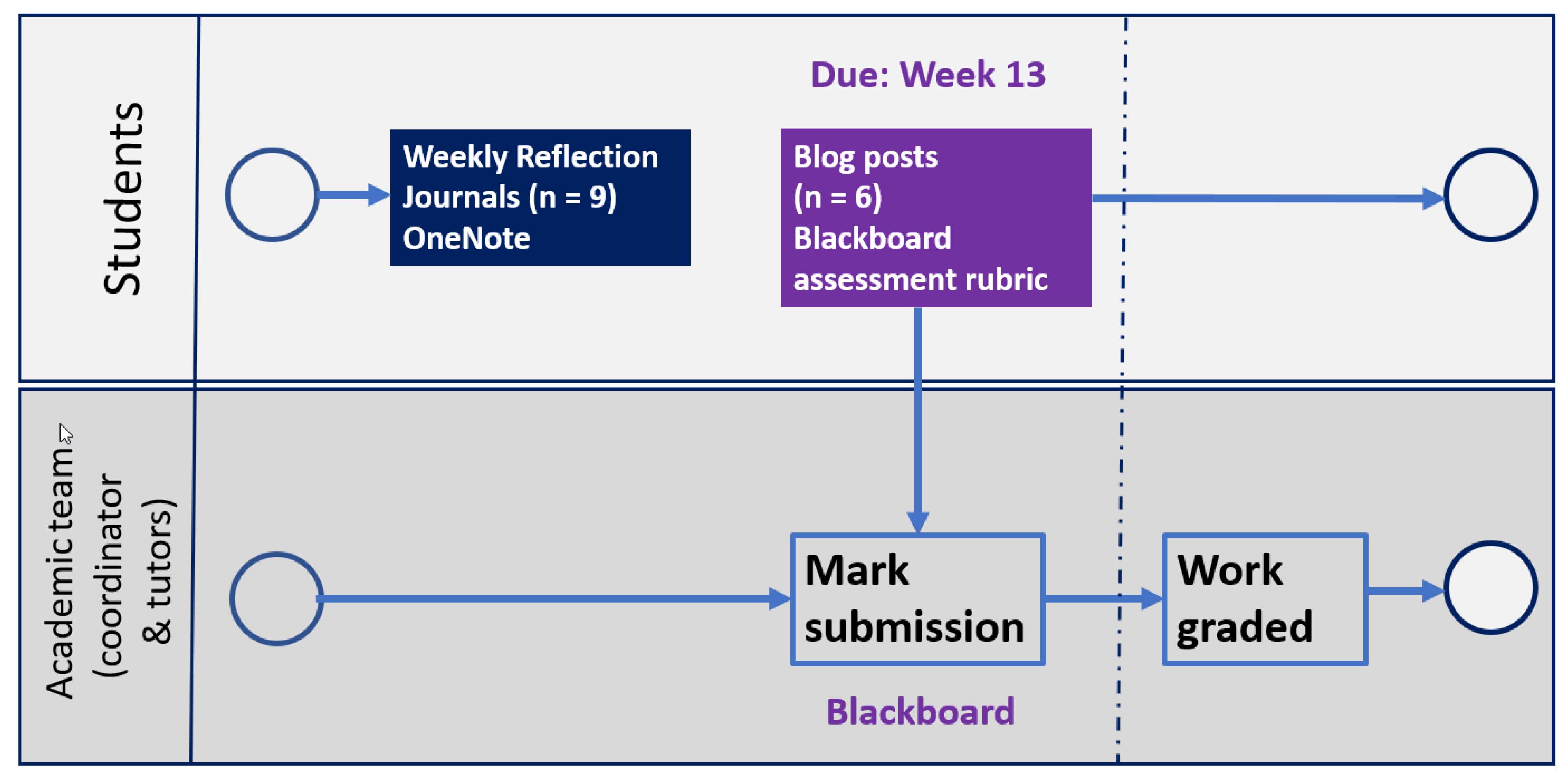
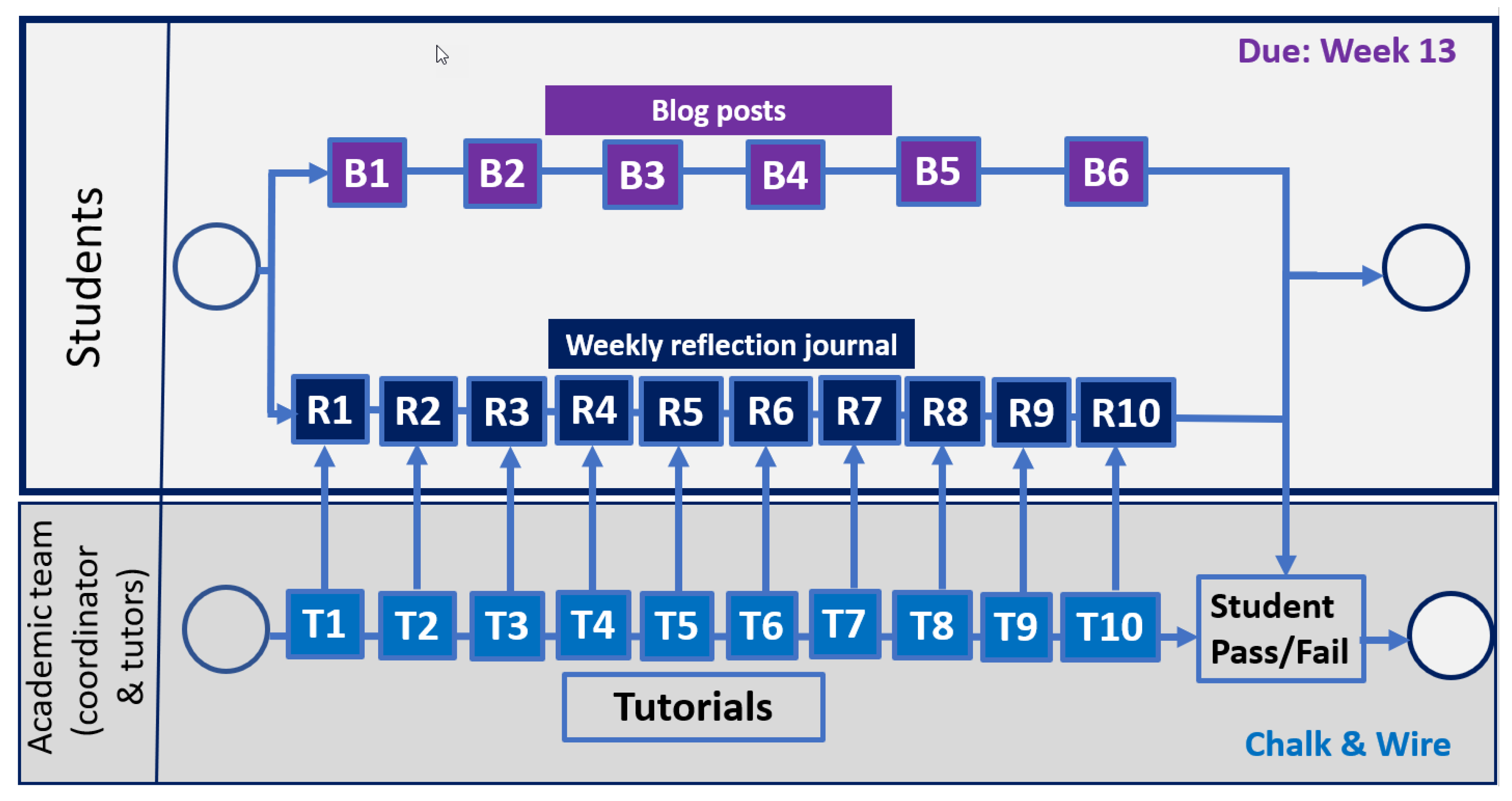

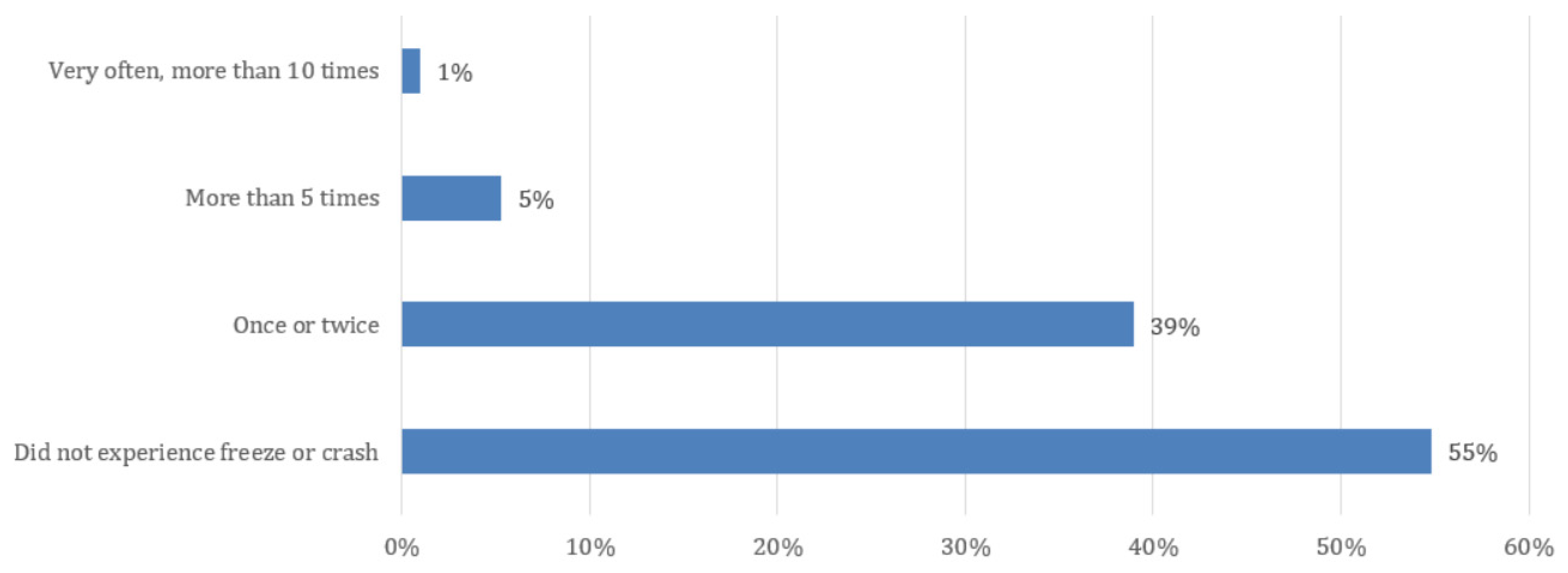
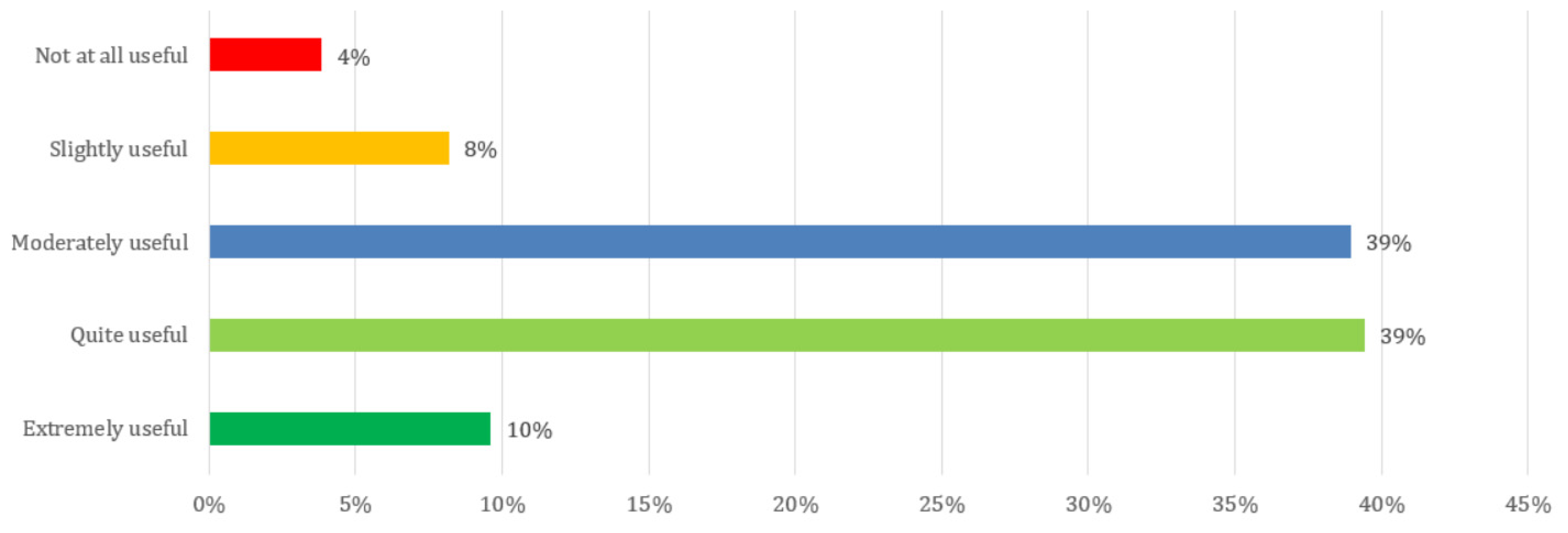

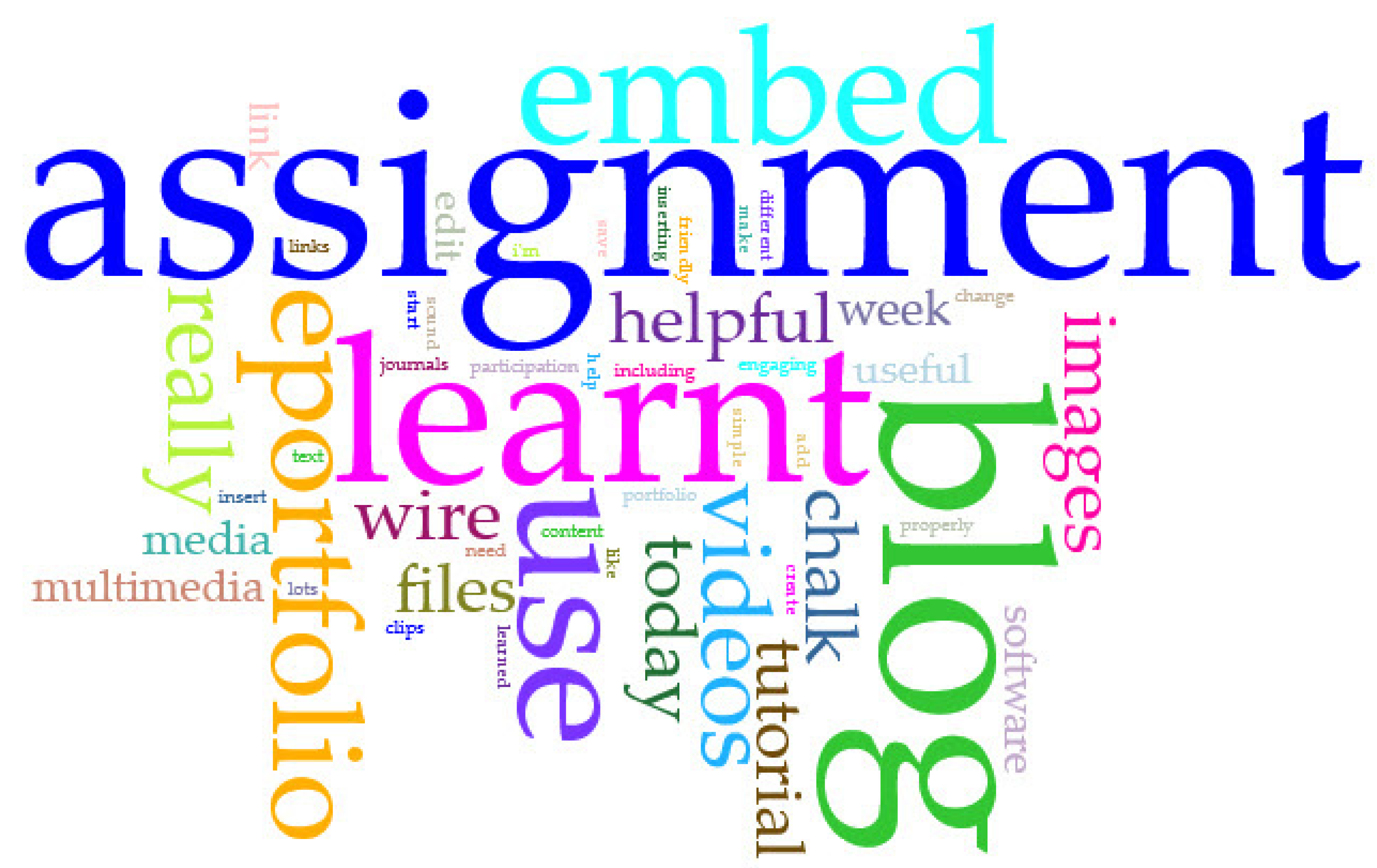
Publisher’s Note: MDPI stays neutral with regard to jurisdictional claims in published maps and institutional affiliations. |
© 2021 by the authors. Licensee MDPI, Basel, Switzerland. This article is an open access article distributed under the terms and conditions of the Creative Commons Attribution (CC BY) license (https://creativecommons.org/licenses/by/4.0/).
Share and Cite
Campbell, C.; Tran, T.L.N. Using an Implementation Trial of an ePortfolio System to Promote Student Learning through Self-Reflection: Leveraging the Success. Educ. Sci. 2021, 11, 263. https://doi.org/10.3390/educsci11060263
Campbell C, Tran TLN. Using an Implementation Trial of an ePortfolio System to Promote Student Learning through Self-Reflection: Leveraging the Success. Education Sciences. 2021; 11(6):263. https://doi.org/10.3390/educsci11060263
Chicago/Turabian StyleCampbell, Chris, and Tran Le Nghi Tran. 2021. "Using an Implementation Trial of an ePortfolio System to Promote Student Learning through Self-Reflection: Leveraging the Success" Education Sciences 11, no. 6: 263. https://doi.org/10.3390/educsci11060263
APA StyleCampbell, C., & Tran, T. L. N. (2021). Using an Implementation Trial of an ePortfolio System to Promote Student Learning through Self-Reflection: Leveraging the Success. Education Sciences, 11(6), 263. https://doi.org/10.3390/educsci11060263





